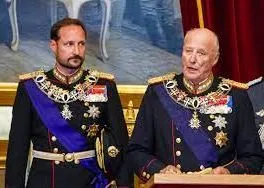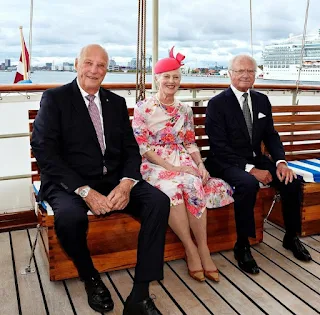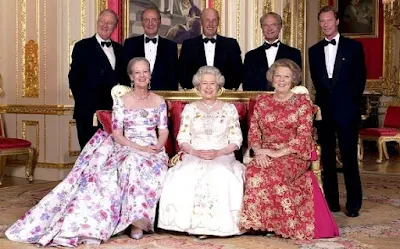With the accession of King Charles III to the British throne, another record has set. He is the oldest monarch in modern Europe to ascend the throne at 73, and the longest king-in-waiting in British history, having held the position as heir-apparent since February 1952.
Queen Margrethe II of Denmark becomes Europe's longest-reigning monarch, and the only reigning Queen in the world today. She is celebrating her 50th anniversary on the Danish throne.
The death of Queen Elizabeth II is the first death of a reigning sovereign in Europe in 17 years, after the death of Prince Rainier III of Monaco in April 2005.
Here are some interesting trivia
Reigning Crown Heads and the start of their reign
- Belgium - Philippe - July 21, 2013
- Denmark - Margrethe II - January 14, 1972
- Liechtenstein - Hans-Adam II - November 13, 1989
- Luxembourg - Henri - October 7, 2000
- Monaco - Albert II - April 6, 2005
- Norway - Harald V - January 17, 1991
- Spain - Felipe VI - June 19, 2014
- Sweden - Carl XVI Gustaf - September 15, 1973
- The Netherlands - Willem-Alexander - April 30, 2013
- United Kingdom - Charles III - September 8, 2022
Royal House name
- Belgium: Saxe-Coburg and Gotha/House of Belgium
- Denmark: Glucksburg
- Liechtenstein: Liechtenstein
- Luxembourg: Luxembourg-Nassau
- Monaco: Grimaldi
- Norway: Glucksburg
- Spain: Bourbon
- Sweden: Bernadotte
- The Netherlands: Orange-Nassau
- United Kingdom: Windsor
Longest reigning monarch. Queen Margrethe II of Denmark. She was born on April 16, 1940. She ascended the throne on January 14, 1972, at the age of 31.
Youngest to ascend the throne. King Carl XVI Gustaf. He was only 27 years old when he succeeded his grandfather, King Adolf VI Gustaf in 1973.
Oldest to ascend the throne. King Charles III. He is 73 years old at the time of his accession to the throne. He will turn 74 this coming November 14, 2022.
Oldest reigning monarch as of September 2022. King Harald V of Norway. He was born on February 21, 1937. He is now 85 years old. He has been on the Norwegian throne for 31 years, since January 17, 1991.
Youngest reigning monarch as of September 2022. King Felipe VI of Spain. He was born on January 30, 1968. As of September 2022, he is 54 years old. He ascended the Spanish throne on June 19, 2014 on the abdication of his father, King Juan Carlos.
Their age when they ascended the throne
- Belgium - King Philippe at the age of 53
- Denmark - Queen Margrethe II at the age of 31
- Liechtenstein - Prince Hans-Adam II at the age of 44
- Luxembourg - Grand Duke Henri at the age of 45
- Monaco - Prince Albert II at the age of 47
- Norway - King Harald V at the age of 53
- Spain - King Felipe VI of Spain at the age of 46
- Sweden - King Carl XVI Gustaf of Sweden at the age of 27
- The Netherlands - Willem-Alexander - at the age of 46
- United Kingdom - King Charles III at the age of 73
- King Harald V of Norway - February 21, 1937 (88 years old)
- Queen Margrethe II of Denmark - April 16, 1940 (82 years old)
- Prince Hans-Adam II of Liechtenstein - February 14, 1945 (77 years old)
- King Carl XVI Gustaf of Sweden - April 30, 1946 (76 years old)
- King Charles III of the UK - November 14, 1948 (73 years old
- Grand Duke Henri of Luxembourg - April 16, 1955 (67 years old)
- Prince Albert II of Monaco - March 14, 1958 (64 years old)
- King Willem-Alexander of The Netherlands - April 27, 1967 (55)
- King Felipe VI of Spain - January 30, 1968 (54 years old)
- Queen Margrethe II of Denmark - 50 years since 1972
- King Carl XVI Gustaf of Sweden - 49 years since 1973
- Prince Hans-Adam II of Liechtenstein - 33 years since 1989
- King Harald V of Norway - 31 years since 1991
- Grand Duke Henri of Luxembourg - 22 years since 2000
- Prince Albert II of Monaco - 17 years since 2005
- King Willem-Alexander of The Netherlands - 9 years since 2013
- King Philippe of the Belgians - 9 years since 2013
- King Felipe VI of Spain - 8 years since 2014
- King Charles III of the UK - less than one month
- Belgium - Princess Elisabeth, The Duchess of Brabant - October 25, 2001
- Denmark - Crown Prince Frederik - May 26, 1968
- Liechtenstein - Alois, The Hereditary Prince - June 11, 1968
- Luxembourg - Guillaume, The Hereditary Grand Duke - November 11, 1981
- Monaco - Jacques, The Hereditary Prince of Monaco, Marquess of Baux - December 10, 2014
- Norway - Crown Prince Haakon - July 20, 1973
- Spain - Leonor, The Princess of Asturias - October 30, 2005
- Sweden - Princess Victoria, Duchess of Vastergotland - July 14, 1977
- The Netherlands - Catharina-Amalia, The Princess of Orange - December 7, 2003
- United Kingdom - William, The Prince of Wales - June 21, 1982
 |
| King Harald V of Norway (right) and his son and heir, Crown Prince Haakon |
Succession Law
Absolute Primogeniture Succession is a succession law that grants equal rights to females. The heir-apparent is the eldest child of the sovereign irrespective of gender.
Male-preference Primogeniture Succession means that males precede females in the line of succession, a younger brother can outrank an older sister in the line of succession.
Agnatic Primogeniture Succession means only males can ascend the throne. Females and their descendants are not eligible to succeed.
- Belgium: Absolute Succession since 1991
- Denmark: Absolute Succession since 2009
- Liechtenstein: Agnatic Succession since the creation of the house
- Luxembourg: Absolute Succession since 2011
- Monaco: Male-Preference Succession
- Norway: Absolute Succession since 1990
- Spain: Male-preference Succession
- Sweden: Absolute Succession since 1980
- The Netherlands: Absolute Succession since 1983
- United Kingdom: Absolute Succession since 2013
- Belgium: None, because prior to the marriage of then Prince Philippe, Duke of Brabant, in 1999, the new succession law was already in place.
- Denmark: None
- Liechtenstein: None
- Luxembourg: Prince Sebastien was outranked by his older sister, Princess Alexandra, in the line of succession following the change.
- Monaco: None
- Norway: None
- Spain: None
- Sweden: Prince Carl Philip was replaced by his older sister, Princess Victoria as the heir-apparent when the law was implemented retroactively in January 1980.
- The Netherlands: None
- United Kingdom: Prince Louis of Cambridge (his title when he was born in 2018) became the first British prince to be outranked by an older sister (Princess Charlotte) in the line of succession.
















0 Comments